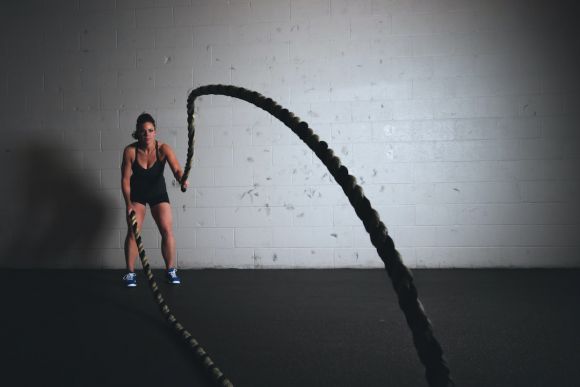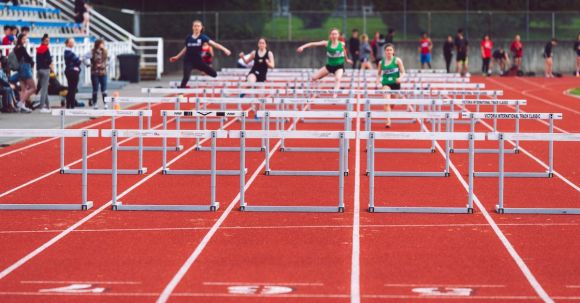Losing weight can be a challenging journey, but with the right tools and strategies, you can achieve your goals more effectively. One such tool that can help you maximize your weight loss results is Fit on, a comprehensive fitness app that provides you with everything you need to succeed. From personalized workout plans to nutrition tracking, Fit on has got you covered. In this article, we will explore how Fit on can help you reach your weight loss goals and transform your body.
Blog Posts
Every athlete knows that to excel in their chosen sport, they need to go beyond their regular training routine. Sports-specific workouts can give you the edge you need to conquer your sport and reach new heights of performance. In this article, we will explore the importance of sports-specific workouts and provide you with some effective exercises to help you dominate on the field, court, or track.
Understanding the Benefits of Sports-Specific Workouts
Sports-specific workouts are tailored to the demands of a particular sport, focusing on the specific muscles, movements, and energy systems involved. These workouts help athletes develop the strength, agility, speed, and endurance required for their specific sport. By training in a way that mimics the movements and intensity of your sport, you can improve your performance and reduce the risk of injury.Effective Sports-Specific Workouts for Different Sports
1. Soccer: - Cone drills: Set up cones in a zigzag pattern and practice dribbling the ball through them at high speed. - Plyometric jumps: Perform box jumps to improve explosiveness and jumping ability. - Interval sprints: Incorporate short bursts of sprinting into your training to simulate the intensity of a soccer match. 2. Basketball: - Lateral lunges: Improve lateral movement and agility by performing lunges to the side. - Jump rope: Jumping rope helps develop foot speed and coordination, essential for basketball players. - Medicine ball exercises: Incorporate medicine ball throws into your workouts to enhance upper body strength and power. 3. Tennis: - Agility ladder drills: Use an agility ladder to improve footwork and quickness on the court. - Forehand and backhand drills: Practice hitting forehand and backhand shots against a wall to improve accuracy and control. - High-intensity interval training: Incorporate short bursts of intense activity, such as sprinting or burpees, to simulate the quick movements required in a tennis match. 4. Track and Field: - Hill sprints: Find a steep hill and sprint up it to develop leg power and improve speed. - Plyometric exercises: Perform exercises like box jumps, bounding, and depth jumps to enhance explosiveness. - Interval training: Alternate between high-intensity sprints and recovery periods to improve endurance and speed. 5. Swimming: - Resistance band exercises: Use resistance bands to simulate the resistance of the water and strengthen your swimming muscles. - Dryland drills: Incorporate dryland exercises such as lunges, squats, and planks to improve overall strength and stability. - Interval swim sets: Alternate between high-intensity sprints and recovery swims to improve endurance and speed in the water.Conclusion: Master Your Sport with Sports-Specific Workouts
Sports-specific workouts are a game-changer for athletes looking to take their performance to the next level. By tailoring your training to the demands of your sport, you can develop the specific skills, strength, and endurance needed to excel. Incorporate these exercises into your training routine, and soon you'll see yourself conquering your sport like never before. Remember, the key to success lies in training smart, focusing on the specific demands of your sport, and pushing yourself to new limits. So, lace up your shoes, grab your equipment, and get ready to dominate your sport with sports-specific workouts.
Maintaining a healthy cardiovascular system is crucial for reducing the risk of stroke. Regular exercise plays a vital role in strengthening the heart and improving blood flow, thus lowering the chances of stroke. In this article, we will explore some effective cardiovascular exercises that can help in reducing the risk of stroke.
1. Aerobic Exercises
Aerobic exercises, also known as cardio exercises, are activities that increase the heart rate and oxygen consumption. These exercises are excellent for improving cardiovascular fitness and reducing the risk of stroke. Some examples of aerobic exercises include brisk walking, jogging, swimming, cycling, and dancing. Aim for at least 150 minutes of moderate-intensity aerobic exercise or 75 minutes of vigorous-intensity exercise per week to reap the maximum benefits.2. High-Intensity Interval Training (HIIT)
HIIT is a form of exercise that involves short bursts of intense activity followed by short periods of rest. This type of training has been found to be highly effective in improving cardiovascular health. HIIT workouts can be tailored to individual fitness levels and can be done with various exercises such as running, cycling, or bodyweight exercises. Incorporating HIIT into your exercise routine can help boost cardiovascular endurance and decrease the risk of stroke.3. Jumping Rope
Jumping rope is a simple yet effective exercise that can provide numerous health benefits, including reducing the risk of stroke. It is a high-intensity cardiovascular exercise that engages multiple muscle groups and improves heart health. Jumping rope can be done at home or outdoors and requires minimal equipment. Start with short intervals and gradually increase the duration as your fitness improves.4. Circuit Training
Circuit training involves performing a series of exercises targeting different muscle groups with minimal rest in between. This type of training not only helps in building strength and endurance but also provides a cardiovascular workout. By incorporating exercises such as push-ups, squats, lunges, and jumping jacks into a circuit, you can elevate your heart rate and improve overall cardiovascular health.5. Swimming
Swimming is a low-impact exercise that is gentle on the joints while providing a great cardiovascular workout. It engages the entire body and helps in improving heart health and lung capacity. Swimming regularly can help reduce the risk of stroke by strengthening the heart, improving circulation, and reducing blood pressure. Aim for at least 30 minutes of swimming three to five times a week to reap its benefits.6. Cycling
Cycling is not only a fun outdoor activity but also an excellent cardiovascular exercise. It can be done at various intensities, making it suitable for people of all fitness levels. Cycling regularly helps in strengthening the heart, improving blood flow, and reducing the risk of stroke. Whether you choose outdoor cycling or indoor cycling on a stationary bike, aim for at least 150 minutes of moderate-intensity cycling per week. In conclusion, Regular cardiovascular exercise is key to reducing the risk of stroke. Incorporating aerobic exercises, high-intensity interval training, jumping rope, circuit training, swimming, and cycling into your fitness routine can help strengthen your heart, improve blood flow, and lower the chances of stroke. Remember to consult with your healthcare provider before starting any new exercise program, especially if you have any pre-existing medical conditions. Stay active, stay healthy, and reduce the risk of stroke through regular cardiovascular exercise.
Maintaining good balance and coordination is essential for overall physical fitness and preventing injuries. While many exercises focus solely on strength or flexibility, incorporating cardio exercises into your routine can help improve your balance and coordination. In this article, we will explore some effective cardio exercises that can enhance your balance and coordination skills.
Jumping Rope
Jumping rope is a fantastic cardio exercise that also challenges your balance and coordination. As you jump and maintain a steady rhythm, you engage your leg muscles, core, and even your arms. The constant bouncing and landing require you to stay balanced and coordinated throughout the exercise. Start with shorter intervals and gradually increase the duration as your skills improve.Boxing
Boxing is a high-intensity cardio exercise that not only improves your cardiovascular endurance but also enhances your balance and coordination. The rapid punches and footwork involved in boxing require you to maintain your balance while moving dynamically. The hand-eye coordination required to hit the target adds another dimension to the exercise, making it a complete workout for both your body and mind.Dancing
Dancing is a fun and enjoyable way to improve your balance and coordination while getting a great cardio workout. Whether it's salsa, hip-hop, or ballet, dancing challenges your body to move in different directions, requiring you to maintain balance and coordination. The intricate footwork and rhythmic movements help improve proprioception, which is your body's ability to sense where it is in space.High-Intensity Interval Training (HIIT)
HIIT workouts involve short bursts of intense exercise followed by periods of rest or lower intensity. These workouts not only improve cardiovascular fitness but also enhance balance and coordination. Exercises like burpees, mountain climbers, and jump squats require you to move quickly and change directions, challenging your balance and coordination. Incorporating HIIT into your routine can help improve your overall physical performance.Cycling
Cycling is a low-impact cardio exercise that can help improve balance and coordination. Whether you're cycling outdoors or using a stationary bike, the act of pedaling requires you to maintain balance and coordination. Additionally, cycling engages your leg muscles, core, and even your upper body, further enhancing your overall stability and coordination.Plyometric Exercises
Plyometric exercises, also known as jump training, are explosive movements that can significantly improve your balance and coordination. Exercises like box jumps, squat jumps, and tuck jumps require you to generate power in a short amount of time, challenging your body's ability to stay balanced and coordinated. Incorporating plyometric exercises into your routine can help improve your overall athleticism.Conclusion: Enhancing Balance and Coordination Through Cardio
Incorporating cardio exercises into your routine is not only beneficial for cardiovascular fitness but also for improving balance and coordination. Jumping rope, boxing, dancing, HIIT, cycling, and plyometric exercises are all effective ways to challenge your body and enhance your overall stability and coordination. Remember to start with shorter durations and gradually increase the intensity as your skills improve. By incorporating these exercises into your routine, you can take your fitness to new heights while improving your balance and coordination skills.
Running is a fantastic way to improve your fitness and overall health. It's a low-cost, accessible exercise that can be done anywhere, at any time. However, for beginners, starting a running routine can seem like a daunting task. The Fit on Running Challenge is designed to help beginners get started on their running journey and conquer their fitness goals. In this article, we will guide you through the steps to successfully complete the Fit on Running Challenge and become a confident runner.
Setting Realistic Goals
Before embarking on the Fit on Running Challenge, it is important to set realistic goals. Running is a progressive activity, and it takes time to build endurance and increase speed. Start by setting small, achievable goals such as running for 10 minutes without stopping or completing a 1-mile run. As you progress, gradually increase the duration and distance of your runs.Finding the Right Gear
Having the proper gear is essential for a comfortable and enjoyable running experience. Invest in a good pair of running shoes that provide adequate support and cushioning. Wear moisture-wicking clothing to keep you cool and dry during your runs. Don't forget to wear a supportive sports bra for women, and a hat or sunglasses for protection from the sun.Warming Up and Cooling Down
Before each run, it is important to warm up your muscles to prevent injury. Start with a brisk walk or light jog for 5-10 minutes to increase blood flow and loosen up your muscles. After your run, take the time to cool down by stretching your muscles. This will help reduce muscle soreness and improve flexibility.Following a Training Plan
The Fit on Running Challenge provides a structured training plan that gradually increases the intensity and duration of your runs over a period of time. This plan is designed to prevent overtraining and injury. Stick to the plan and avoid the temptation to push yourself too hard too soon. Listen to your body and take rest days when needed.Building Endurance
Building endurance is a key component of the Fit on Running Challenge. Start by incorporating a combination of running and walking into your routine. For example, run for 1 minute, then walk for 1 minute, and repeat for a total of 20 minutes. As you progress, gradually increase the running time and decrease the walking time. Eventually, you will be able to run continuously without the need for walking breaks.Staying Motivated
Staying motivated is essential for completing the Fit on Running Challenge. Find a running buddy or join a running group to keep you accountable and motivated. Set rewards for yourself after completing milestones, such as treating yourself to a new running gear or a massage. Keep track of your progress and celebrate your achievements along the way.Listening to Your Body
Listening to your body is crucial when participating in the Fit on Running Challenge. Pay attention to any pain or discomfort and take appropriate action. If you experience persistent pain, consult a healthcare professional. Rest when needed and don't be discouraged by setbacks. Remember, progress takes time, and every step forward is a step towards your fitness goals. Conclusion: Conquering the Fit on Running Challenge for beginners is an achievable goal with the right mindset, preparation, and dedication. By setting realistic goals, finding the right gear, and following a training plan, you will be well on your way to becoming a confident runner. Remember to listen to your body, stay motivated, and celebrate your achievements along the way. Lace up your running shoes and start your Fit on Running Challenge today!
Muscle recovery is an essential part of any fitness routine. After an intense workout, your muscles need time to repair and rebuild themselves. One crucial factor in this process is nutrition. What you eat can greatly affect how quickly your muscles recover and how well they adapt to the stress of exercise. In this article, we will explore the best foods for muscle recovery and how they can help you achieve optimal results.
Protein-packed Powerhouses
Protein is the building block of muscle tissue, making it an essential nutrient for muscle recovery. Consuming an adequate amount of protein after a workout can help speed up the repair and rebuilding of your muscles. Lean sources of protein such as chicken, fish, eggs, and tofu are excellent choices. These foods not only provide the necessary amino acids for muscle repair but also offer other important nutrients like vitamins and minerals.Supercharge with Superfoods
Certain foods are known for their high nutrient content and powerful antioxidants, making them ideal for muscle recovery. Blueberries, for example, are packed with antioxidants that can help reduce inflammation and oxidative stress caused by intense exercise. Other superfoods like spinach, kale, and broccoli are rich in vitamins and minerals that can aid in the repair and growth of muscle tissue. Including these superfoods in your post-workout meals can provide the necessary nutrients to support muscle recovery.Carbohydrates for Energy
While protein is crucial for muscle repair, carbohydrates play a vital role in replenishing energy stores. Consuming carbohydrates after a workout helps restore glycogen levels, which are depleted during intense exercise. Opt for complex carbohydrates like whole grains, sweet potatoes, and quinoa, as they provide a steady release of energy and are rich in fiber, vitamins, and minerals. Including a source of carbohydrates in your post-workout meal can help replenish energy levels and support muscle recovery.Healthy Fats for Inflammation
Although fats often get a bad reputation, certain types of fats can be beneficial for muscle recovery. Omega-3 fatty acids, found in fatty fish like salmon, trout, and mackerel, have anti-inflammatory properties that can help reduce muscle soreness and inflammation. Nuts, seeds, and avocado are also excellent sources of healthy fats that can aid in muscle recovery. Including these foods in your diet can help reduce inflammation and promote faster muscle repair.Hydrate for Optimal Recovery
Proper hydration is often overlooked but is crucial for muscle recovery. During exercise, you lose fluids through sweat, and adequate hydration is necessary to maintain optimal muscle function. Drinking enough water before, during, and after your workout can help prevent dehydration and support the recovery process. Additionally, electrolytes like potassium and magnesium, found in foods like bananas and leafy greens, can aid in the rehydration process and prevent muscle cramps.Timing is Key
While knowing the best foods for muscle recovery is important, timing your meals correctly is equally crucial. Consuming a balanced meal containing protein, carbohydrates, and healthy fats within 30 minutes to an hour after your workout can maximize the benefits of muscle recovery. This window of time, known as the "anabolic window," is when your muscles are most receptive to nutrient uptake. By providing your body with the necessary nutrients during this window, you can optimize muscle repair and growth. Incorporating these foods into your post-workout meals can greatly enhance muscle recovery and improve overall performance. Remember to focus on lean sources of protein, include superfoods packed with nutrients, replenish energy stores with complex carbohydrates, incorporate healthy fats to reduce inflammation, and hydrate properly. By following these guidelines, you can ensure that your muscles have the best chance to recover and adapt to the demands of your exercise routine. So, fuel your body with the right foods and watch your muscles grow stronger and more resilient with each workout.
Are you looking for a new and exciting way to get fit? Look no further than the Fit on Hiit Challenge! High-intensity interval training (HIIT) has gained popularity in recent years for its ability to deliver maximum results in a short amount of time. If you're ready to push your limits and see what you're capable of, then this challenge is for you. Get ready to sweat and transform your body with the Fit on Hiit Challenge!
What is HIIT?
Before we dive into the Fit on Hiit Challenge, let's first understand what HIIT is all about. HIIT is a type of workout that alternates between intense bursts of exercise and short recovery periods. The idea behind HIIT is to elevate your heart rate and keep it elevated throughout the workout, leading to increased calorie burn and improved cardiovascular endurance.The Fit on Hiit Challenge
The Fit on Hiit Challenge is a 30-day program designed to help you reach your fitness goals. Whether you want to lose weight, build muscle, or increase your overall fitness level, this challenge has got you covered. Each day, you'll be provided with a new HIIT workout that you can do from the comfort of your own home or at the gym. These workouts are designed to be challenging yet manageable, allowing you to push yourself to new heights.Benefits of HIIT
HIIT offers a wide range of benefits that make it an ideal workout for those looking to get fit. Here are just a few of the many benefits of HIIT: 1. Time-efficient: HIIT workouts are typically shorter in duration compared to traditional workouts, making them perfect for those with busy schedules. 2. Increased calorie burn: HIIT workouts can help you burn more calories in a shorter amount of time, making it an effective way to lose weight. 3. Improved cardiovascular health: HIIT workouts get your heart rate up, leading to improved cardiovascular endurance and overall heart health. 4. Muscle building: HIIT workouts incorporate both cardio and strength exercises, helping you build lean muscle mass. 5. No equipment necessary: HIIT workouts can be done with little to no equipment, making them accessible to everyone.Tips for Success
To make the most of the Fit on Hiit Challenge, here are some tips to help you succeed: 1. Stay consistent: Commit to completing the workouts every day for 30 days to see the best results. 2. Listen to your body: While HIIT is intense, it's important to listen to your body and modify exercises if needed. Push yourself, but don't overdo it. 3. Fuel your body: Eating a balanced diet and staying properly hydrated will help you perform your best during the challenge. 4. Track your progress: Keep track of your workouts and any changes you notice in your body or fitness level. This will help keep you motivated and accountable. Join the Fit on Hiit Challenge Today! If you're ready to take your fitness to the next level, join the Fit on Hiit Challenge today! Get ready to sweat, push your limits, and see incredible results in just 30 days. Remember, the only thing standing between you and your goals is your commitment and willingness to put in the work. So lace up your sneakers, grab a water bottle, and let's get started on this exhilarating fitness journey. Don't wait - join the Fit on Hiit Challenge now and transform your body like never before!
Introduction:
Maintaining good posture is essential for overall health and well-being. Unfortunately, many people struggle with poor posture, which can lead to a variety of problems, including back pain. While there are various ways to improve posture, incorporating cardio exercises into your fitness routine can be highly effective. In this article, we will explore some cardio exercises that can help improve your posture and reduce back pain.
1. Running:
Running is a fantastic cardio exercise that engages multiple muscle groups, including the back, core, and legs. By incorporating running into your routine, you can strengthen these muscles, leading to improved posture and reduced back pain. Start with a slow jog and gradually increase your speed and distance over time. Remember to maintain an upright posture while running, with your shoulders back and head held high.
2. Cycling:
Cycling is another excellent cardio exercise for improving posture and reducing back pain. Whether you prefer outdoor cycling or indoor cycling classes, this activity targets the muscles in your back and core, promoting better alignment and reducing stress on your spine. Make sure to adjust your bike seat and handlebars to ensure proper posture while cycling. Aim for at least 30 minutes of cycling a few times a week to see significant improvements in your posture.
3. Swimming:
Swimming is a low-impact cardio exercise that provides a full-body workout. It is especially beneficial for individuals with back pain or joint issues. The resistance of the water helps strengthen the muscles in your back and core, leading to improved posture. Additionally, swimming promotes flexibility and decreases the likelihood of muscle imbalances, which can contribute to poor posture. Try incorporating different swimming strokes into your routine, such as freestyle and backstroke, to target various muscle groups.
4. Jumping rope:
Jumping rope is a fun and effective cardio exercise that can be done anywhere. Not only does it improve cardiovascular fitness, but it also strengthens the muscles in your back and shoulders, helping to correct posture. As you jump, focus on keeping your core engaged and shoulders relaxed. Start with shorter intervals and gradually increase the duration as your endurance improves. Jumping rope for just 10-15 minutes a day can yield significant benefits for your posture.
5. High-intensity interval training (HIIT):
HIIT workouts are intense, short bursts of activity followed by brief rest periods. These workouts effectively raise your heart rate while also engaging multiple muscle groups. Incorporating exercises like burpees, squat jumps, and mountain climbers into your HIIT routine can help strengthen your back and core muscles, leading to improved posture. To maximize the benefits, focus on maintaining correct form throughout each exercise.
Conclusion:
Improving your posture and reducing back pain can have a profound impact on your overall quality of life. By incorporating these cardio exercises into your fitness routine, you can strengthen the muscles that support good posture and decrease the likelihood of back pain. Remember to start slowly and gradually increase the intensity and duration of your workouts. Consistency is key, so aim for at least 30 minutes of cardio exercise most days of the week. With time and dedication, you'll notice significant improvements in your posture and a reduction in back pain.
Improving cardiovascular fitness is an essential aspect of maintaining a healthy lifestyle. Regular cardio exercises, such as running, cycling, or swimming, can help strengthen the heart, improve lung capacity, and boost overall endurance. But how do you know if you are making progress in your cardiovascular fitness journey? Tracking your progress is crucial as it not only helps you stay motivated but also allows you to make necessary adjustments to your workout routine. In this article, we will explore some effective methods to track your progress in cardiovascular fitness.
Set Goals
Before you start tracking your progress, it is important to set clear and achievable goals. Having specific targets will provide you with a sense of direction and purpose. For example, you might aim to run a certain distance within a certain time frame or be able to cycle uphill without feeling exhausted. By establishing goals, you can measure your progress more effectively.Keep a Workout Journal
A workout journal can be a valuable tool in tracking your cardiovascular fitness progress. By recording your workouts, you can keep track of the duration, intensity, and type of exercises you perform. Additionally, you can make notes about how you felt during the workout and any milestones you achieved. Over time, you will be able to review your journal and see how far you have come in terms of your fitness level.Monitor Heart Rate
Monitoring your heart rate is another effective way to track your cardiovascular fitness progress. As you become fitter, your heart rate will become more efficient, meaning it will take less effort for your heart to pump blood around your body. One way to monitor your heart rate is by using a fitness tracker or a heart rate monitor. These devices can provide real-time feedback and help you stay within your target heart rate zone during workouts.Perform Regular Fitness Tests
Regular fitness tests can provide valuable insights into your cardiovascular fitness progress. There are several tests you can perform, such as the Cooper test, the 1-mile walk test, or the beep test. These tests measure your cardiovascular endurance and can be a great way to gauge your progress over time. By repeating these tests every few months, you can see if you are improving and identify areas that may need more focus.Track Your Resting Heart Rate
Your resting heart rate, which is the number of times your heart beats per minute when you are at rest, can also serve as an indicator of your cardiovascular fitness. As you become fitter, your resting heart rate tends to decrease. You can easily track your resting heart rate by measuring it first thing in the morning before getting out of bed. By keeping track of your resting heart rate over time, you can observe any changes and evaluate your cardiovascular fitness progress.Celebrate Milestones
Tracking your progress in cardiovascular fitness is not just about the numbers. It's also important to celebrate the milestones you achieve along the way. Whether it's running your first 5k or completing a challenging cycling route, acknowledging your achievements can help boost your motivation and keep you on track. Remember to reward yourself for your hard work and dedication. In conclusion, tracking your progress in cardiovascular fitness is crucial for maintaining motivation and making necessary adjustments to your workout routine. By setting goals, keeping a workout journal, monitoring your heart rate, performing regular fitness tests, tracking your resting heart rate, and celebrating milestones, you can effectively measure your progress and stay on the path to a healthier, fitter you. So, lace up your sneakers, grab your fitness tracker, and start tracking your way to improved cardiovascular fitness.
In today's fast-paced world, it is essential to have good cardiovascular endurance. Whether you are an athlete, a fitness enthusiast, or someone who simply wants to improve their overall health, having a strong cardiovascular system is crucial. It allows you to perform physical activities for longer periods without feeling tired and out of breath. If you want to boost your cardiovascular endurance, here are some practical tips to get you started.









